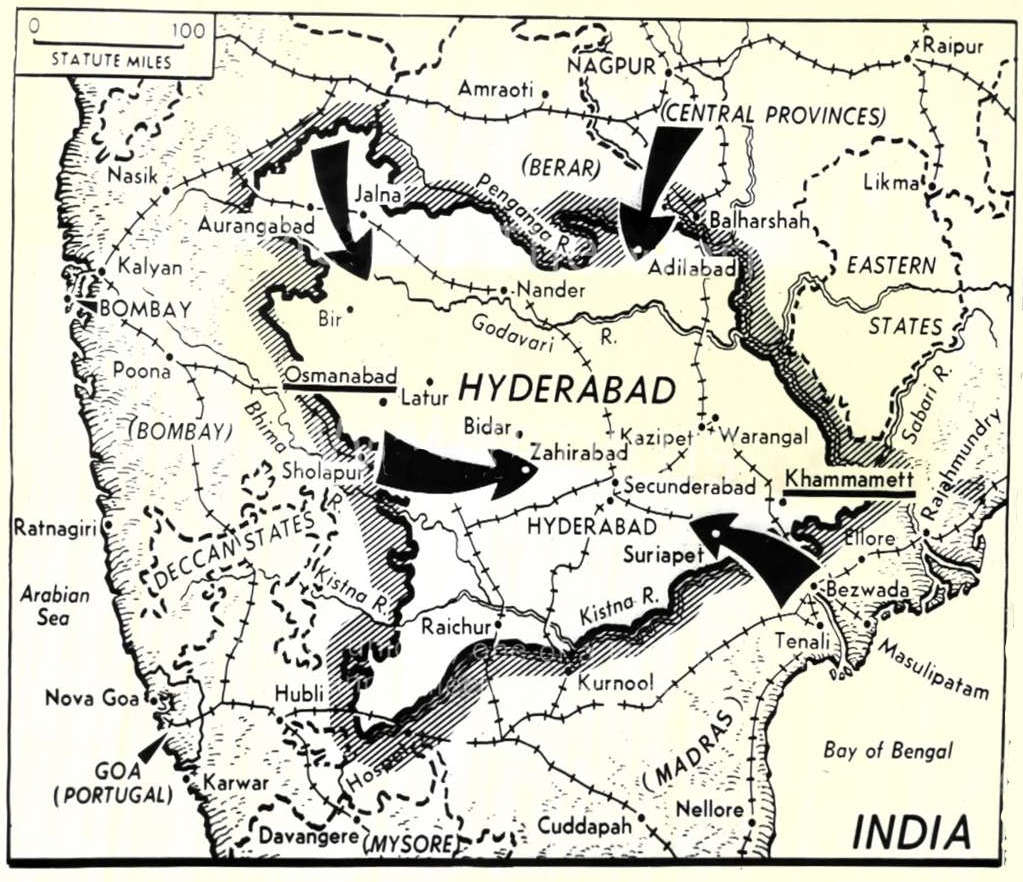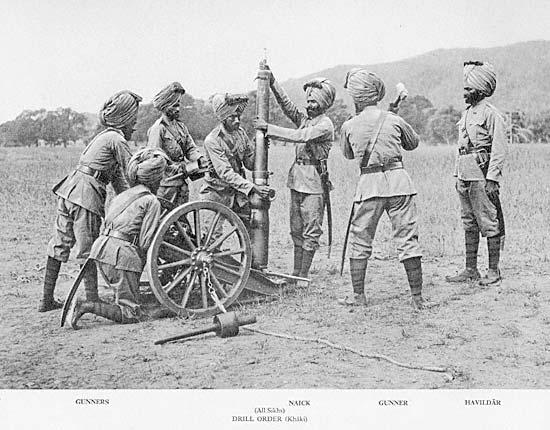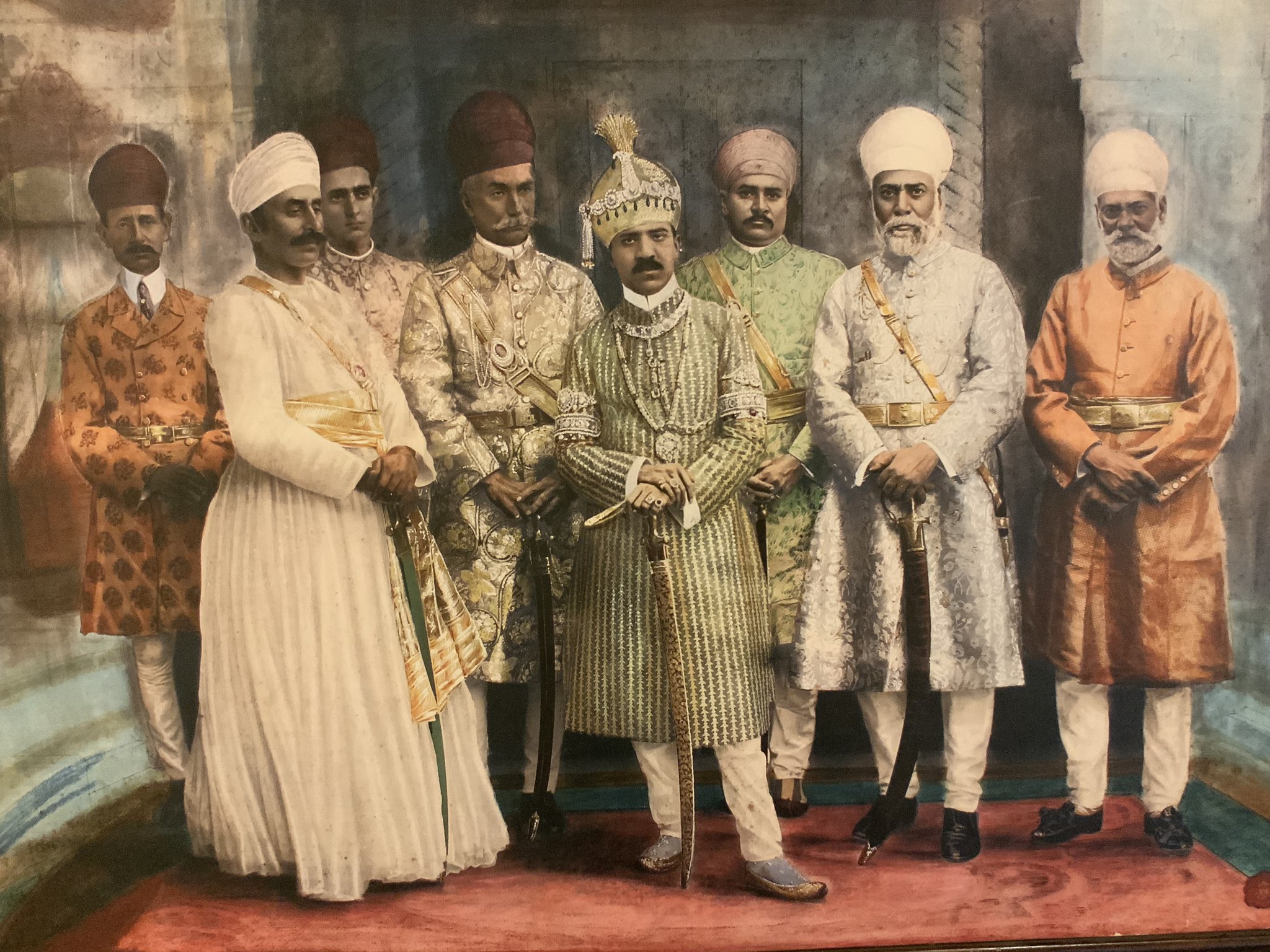|
Indian Annexation Of Hyderabad
Operation Polo was the code name of the Hyderabad "police action" in September 1948, by the then newly independent Dominion of India against Hyderabad State. It was a military operation in which the Indian Armed Forces invaded the Nizam-ruled princely state, annexing it into the Indian Union. At the time of Partition in 1947, the princely states of India, who in principle had self-government within their own territories, were subject to subsidiary alliances with the British, giving them control of their external relations. With the Indian Independence Act 1947, the British abandoned all such alliances, leaving the states with the option of opting for full independence. However, by 1948 almost all had acceded to either India or Pakistan. One major exception was that of the wealthiest and most powerful principality, Hyderabad, where the Nizam, ''Mir'' Osman Ali Khan, Asaf Jah VII, a Muslim ruler who presided over a largely Hindu population, chose independence and hoped to main ... [...More Info...] [...Related Items...] OR: [Wikipedia] [Google] [Baidu] |
Hyderabad State
Hyderabad State () was a princely state located in the south-central Deccan region of India with its capital at the city of Hyderabad. It is now divided into the present-day state of Telangana, the Kalyana-Karnataka region of Karnataka, and the Marathwada region of Maharashtra in India. The state was ruled from 1724 to 1857 by the Nizam, who was initially a viceroy of the Mughal empire in the Deccan. Hyderabad gradually became the first princely state to come under British paramountcy signing a subsidiary alliance agreement. During British rule in 1901 the state had an average revenue of Rs. 417,000,000, making it the wealthiest princely state in India. The native inhabitants of Hyderabad Deccan, regardless of ethnic origin, are called "Mulki" (countryman), a term still used today. The dynasty declared itself an independent monarchy during the final years of the British Raj. After the Partition of India, Hyderabad signed a standstill agreement with the new dominion of India ... [...More Info...] [...Related Items...] OR: [Wikipedia] [Google] [Baidu] |
Indian Armed Forces
The Indian Armed Forces are the military forces of the Republic of India. It consists of three professional uniformed services: the Indian Army, Indian Navy, and Indian Air Force.—— Additionally, the Indian Armed Forces are supported by the Central Armed Police Forces, Assam Rifles, Indian Coast Guard and Special Frontier Force and various inter-service commands and institutions such as the Strategic Forces Command, the Andaman and Nicobar Command and the Integrated Defence Staff. The President of India is the Supreme Commander of the Indian Armed Forces but the executive authority and responsibility for national security is vested in the Prime Minister of India and their chosen Cabinet Ministers. The Indian Armed Forces are under the management of the Ministry of Defence of the Government of India. With strength of over 1.4 million active personnel, it is the world's second-largest military force and has the world's largest volunteer army. It also has the thi ... [...More Info...] [...Related Items...] OR: [Wikipedia] [Google] [Baidu] |
Qasim Razvi
Syed Kasim Razvi (also Qasim Razvi; 17 July 1902 – 15 January 1970) was a politician in the princely state of Hyderabad. He was the president of the Majlis-e-Ittehadul Muslimeen party from December 1946 until the state's accession to India in 1948. He was also the founder of the Razakar militia in the state. He held the levers of power with the Nizam of Hyderabad, blocking the possibilities of his accommodation with the Dominion of India. According to scholar Lucien Benichou, " azvican arguably be considered to have been the political figure whose influence and unrealistic vision proved the most detrimental to the interests of the State in the crucial years of 1947–48." Early life and career Kasim Razvi was born in United ProvincesSyed Qasim Husain Rizvi Geni database, 20 January 2015. and studied law ... [...More Info...] [...Related Items...] OR: [Wikipedia] [Google] [Baidu] |
General El Edroos
Syed Ahmed El-Edroos () was the commander-in-chief of the Hyderabad State Forces at the time of the annexation of Hyderabad State by India in 1948. Life Syed Ahmed El-Edroos was of Arab Hadhrami descent. He was a Ba'Alawi Sayyed of the Bani Hashim meaning he belonged to a Hashemite family i.e. a direct descendant of the Islamic prophet Muhammad. He was commissioned in 1919. El-Edroos participated in both World Wars, serving in the 1st Hyderabad Lancers. El-Edroos was a close confidante and trusted aide of the Nizam of Hyderabad. His brothers were also senior officers and distinguished members of the Nizam's army. He was ready for a war , but was advised by the Nizam of Hyderabad, Mir Osman Ali Khan, not to fight and surrendered to the Indian Army forces outside of Hyderabad city so that there is no bloodshed of innocent people. In September 1948 El-Edroos held the rank of Major-General and Commander of the State Army of Hyderabad. This numbered 6,000 men and consisted o ... [...More Info...] [...Related Items...] OR: [Wikipedia] [Google] [Baidu] |
Mir Osman Ali Khan
Mir Osman Ali Khan, Asaf Jah VII (5 or 6 April 1886 — 24 February 1967), was the last Nizam (ruler) of the Princely State of Hyderabad, the largest princely state in British India. He ascended the throne on 29 August 1911, at the age of 25 and ruled the Kingdom of Hyderabad between 1911 and 1948, until India annexed it. He was styled as His Exalted Highness-(H.E.H) the Nizam of Hyderabad, and was widely considered as one of the world's wealthiest person of all time. With some estimate placing his wealth at 2% of U.S. GDP, his portrait was on the cover of ''Time magazine'' in 1937. As a semi-autonomous monarch, he had his own mint, printing his own currency, the Hyderabadi rupee, and had a private treasury that was said to contain £100 million in gold and silver bullion, and a further £400 million of jewels (in 2008 terms). The major source of his wealth was the Golconda mines, the only supplier of diamonds in the world at that time. Among them was the Jacob Diamond ... [...More Info...] [...Related Items...] OR: [Wikipedia] [Google] [Baidu] |
Nizam Of Hyderabad
The Nizams were the rulers of Hyderabad from the 18th through the 20th century. Nizam of Hyderabad (Niẓām ul-Mulk, also known as Asaf Jah) was the title of the monarch of the Hyderabad State ( divided between the state of Telangana, Marathwada, Marathwada region of Maharashtra and Kalyana-Karnataka region of Karnataka). ''Nizam'', shortened from ''Nizam-ul-Mulk'', meaning ''Administrator of the Realm'', was the title inherited by Asaf Jah I. He was the former ''Naib'' (suzerain) of the Great Mughal in the Deccan, the premier courtier of Mughal India until 1724, the founding of an independent monarchy as the "Nizam (title) of Hyderabad". The Asaf Jahi dynasty was founded by Qamar-ud-din Khan, Asaf Jah I, Mir Qamar-ud-Din Siddiqi (Asaf Jah I), who served as a ''Naib'' of the Deccan sultanates under the Moghul Empire from 1713 to 1721. He intermittently ruled the region after Emperor Aurangzeb's death in 1707. In 1724 Mughal control weakened, and Asaf Jah became virtually ... [...More Info...] [...Related Items...] OR: [Wikipedia] [Google] [Baidu] |
Subroto Mukherjee
Air Marshal Subroto Mukerjee OBE (Bengali: সুব্রত মুখোপাধ্যায়) (5 March 1911 – 8 November 1960) was an Indian military officer who was the first Commander-in-Chief (C-in-C) of the Indian Air Force. He was awarded several honours during the course of a three-decade-long career, ended by his untimely demise in 1960. He has been called the ''Father of the Indian Air Force''. Born in a Bengali family of repute, he was educated both in India and in the United Kingdom. He joined the Royal Air Force and later was one of the first recruits of the Indian Air Force (IAF) in 1933. He flew with the No. 1 Squadron IAF from 1933 to 1941. He saw extensive action in the North-West Frontier Province during this stint and was mentioned in dispatches. He attended the Staff College, Quetta in 1941 before returning to command No. 1 Squadron in 1942. He commanded the RAF Station Kohat from 1943 to 1944 before moving to Air HQ as director of flying training. H ... [...More Info...] [...Related Items...] OR: [Wikipedia] [Google] [Baidu] |
Air Vice-Marshal
Air vice-marshal (AVM) is a two-star air officer rank which originated in and continues to be used by the Royal Air Force. The rank is also used by the air forces of many countries which have historical British influence and it is sometimes used as the English translation of an equivalent rank in countries which have a non-English air force-specific rank structure. Air vice-marshal is a two-star rank and has a NATO ranking code of OF-7. It is equivalent to a rear-admiral in the Royal Navy or a major-general in the British Army or the Royal Marines. In other NATO forces, such as the United States Armed Forces and the Canadian Armed Forces, the equivalent two-star rank is major general. The rank of air vice-marshal is immediately senior to the rank air commodore and immediately subordinate to the rank of air marshal. Since before the Second World War it has been common for air officers commanding RAF groups to hold the rank of air vice-marshal. In small air forces such as ... [...More Info...] [...Related Items...] OR: [Wikipedia] [Google] [Baidu] |
Ajit Rudra
Major General Ajit Anil "Jik" Rudra OBE (20 October 1896 – 3 November 1993) was an Indian military officer who served as General Officer Commanding, Southern Command of the Indian Army. Early life and education Born in Delhi to the famous educationist S. K. Rudra and Priyobala Singha, he was educated at St. Stephen's College, Delhi and at Trinity College, Kandy in Ceylon. He thereafter went on to attend University of Cambridge. Marriage Jik married Edith Lall on 16th November 1923 at Lahore Cathedral. Military career With the out break of World War I, Rudra enlisted in the British Army leaving Cambridge to join the University and Public School Brigade and took part in the Battle of Mons. Having not been qualified for a commission he joined the 2nd Battalion of the Royal Fusiliers and took part in the Battle of the Somme having been one of the 80 odd survivors of the charge of the 500 Fusiliers. He went on to become a sergeant and was wounded. In 1918, he was selected for ... [...More Info...] [...Related Items...] OR: [Wikipedia] [Google] [Baidu] |
Joyanto Nath Chaudhuri
General Jayanto Nath Chaudhuri (Bengali: জয়ন্তনাথ চৌধুরী; 10 June 1908 – 6 April 1983) was a General Officer in the Indian Army. He served as the 6th Chief of Army Staff from 1962 to 1966 and the Military Governor of Hyderabad State from 1948 to 1949. After his retirement from the Indian Army, he served as the Indian High Commissioner to Canada from 19 July 1966 until August 1969. Family background and early life Chaudhuri was born into an aristocratic and distinguished Bengali Brahmin family which produced many renowned lawyers and writers. His family were the ''Zamindars'' (landlords) of Haripur and the family was known as the Chaudhuris of Haripur in the province of Bengal, British India. Chaudhuri's paternal grandfather, Durgadas Chaudhuri, was the landlord of Chatmohar Upazila of Pabna district of present-day Bangladesh. His paternal grandmother, Sukumari Devi (wife of Durgadas), was a sister of the nobel laureate Rabindranath Tagore. ... [...More Info...] [...Related Items...] OR: [Wikipedia] [Google] [Baidu] |
Major General
Major general (abbreviated MG, maj. gen. and similar) is a military rank used in many countries. It is derived from the older rank of sergeant major general. The disappearance of the "sergeant" in the title explains the apparent confusion of a lieutenant general outranking a major general, whereas a major outranks a lieutenant. In the Commonwealth of Nations, Commonwealth and in the United States, when appointed to a field command, a major general is typically in command of a Division (military), division consisting of around 6,000 to 25,000 troops (several regiments or brigades). It is a two-star general, two-star rank that is subordinate to the rank of lieutenant general and senior to the rank of brigadier or brigadier general. In the Commonwealth, major general is equivalent to the navy rank of rear admiral. In air forces with a separate rank structure (Commonwealth), major general is equivalent to air vice-marshal. In some countries including much of Eastern Europe, major ... [...More Info...] [...Related Items...] OR: [Wikipedia] [Google] [Baidu] |




